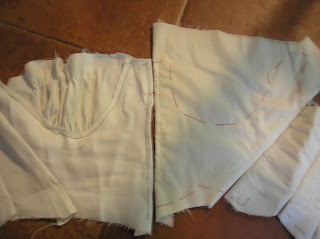Stays Progress
At last! I've done all of the channels that go along seams on the right half of the stays. Next step is to sew the pieces together and check to see if they fit along the underbust, since that's pretty important to making the cups work. I think quilting is going to be my last step, after I'm sure everything fits - there should be a good amount of it, since period references talk about how omg these shocking French corsets are mostly quilted . However, I have two other projects to take into account - a few months ago I participated in the help_japan auction on Livejournal, and I really need to knit the socks that my high bidder won. I also said that I would make a dress for one of my bosses/supervisors at the museum where I'm interning/volunteering to wear to a gala. So I need to get on them. I feel awful for making my auction recipient wait, but at least there isn't really a deadline there.








